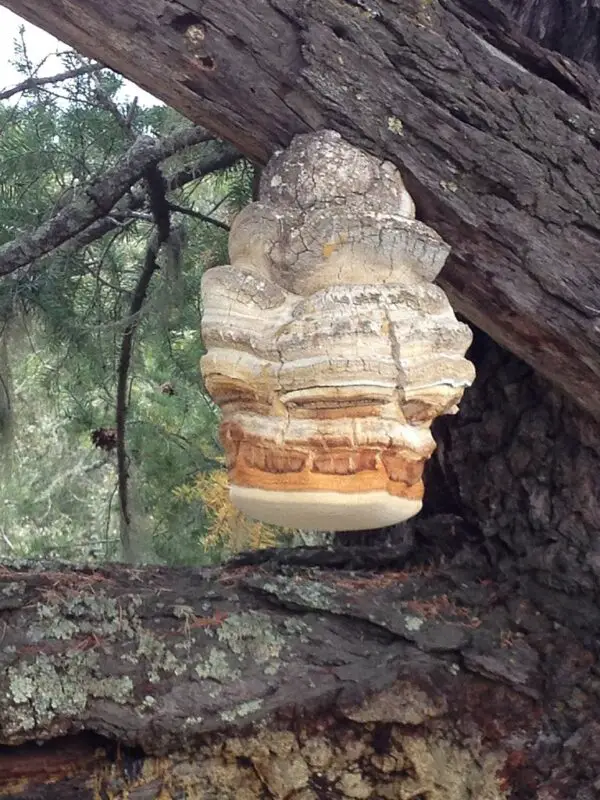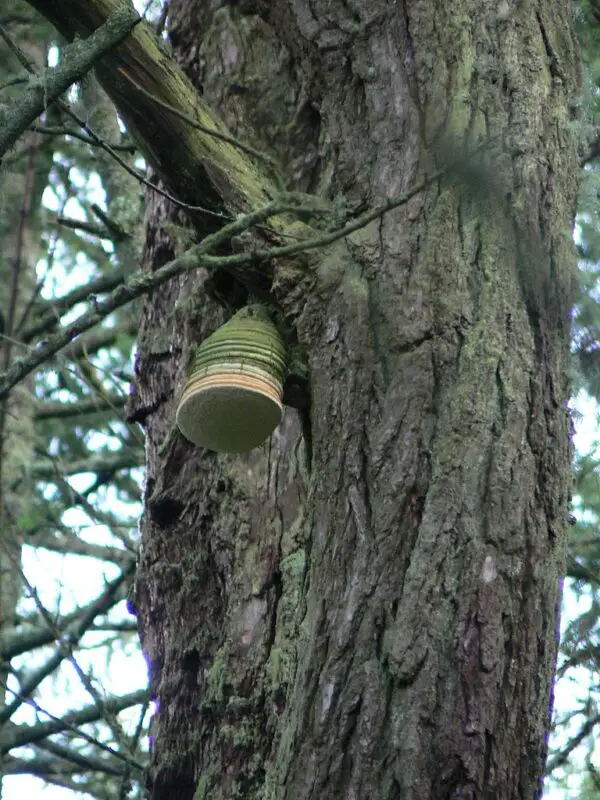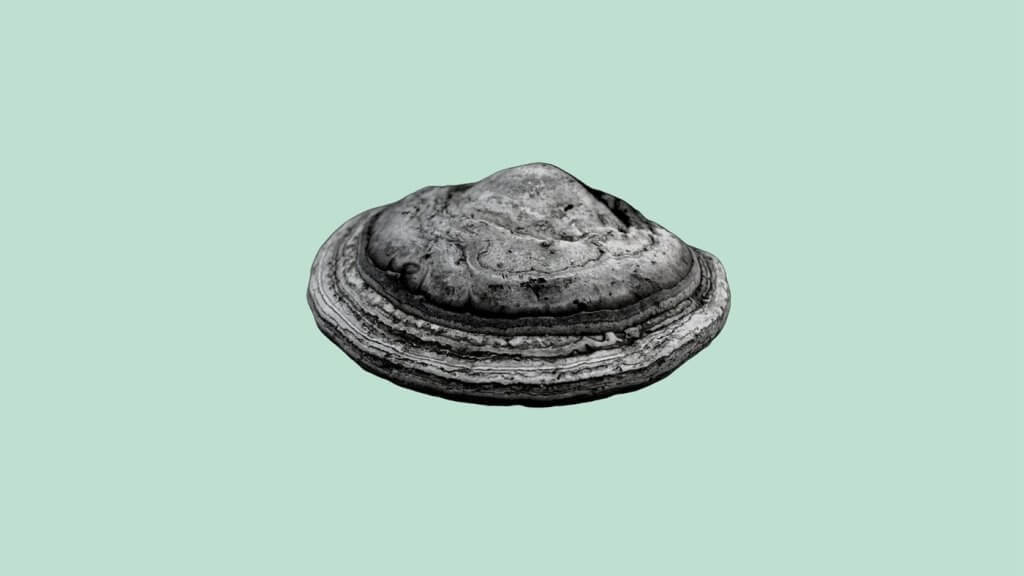Native to North America, agarikon is not edible in the ordinary sense that you would eat a common button mushroom. One of this mushroom's most important uses is its health benefits. More traditionally, people use this mushroom extract to treat various infectious diseases, including tuberculosis (TB), herpes, and as a treatment for malaria.
Laricifomes Officinalis Profile
The scientific name for these medicinal mushrooms is Laricifomes officinalis, but its more common names include:
- Agarikon eburiko
- The quinine conk
- Fomitopsis officinalis (although less common)
The Laricifomes officinalis is almost identical to the Fomitopsis. Both names are used interchangeably. But, these mushrooms are most definitely from the distinct and separate genera’ of Fomitopsis and Laricifomes.
The agarikon often causes brown heart rot on conifers as a wood-decay fungus. This fungus is also part of the Polyporales order, meaning the fruiting bodies grow on tree trunks in large conks.
What Are You Foraging For Right Now?
We're thrilled to hear your ideas. What would you like to submit today? Feel free to share your thoughts and experiences with us.
Some specimens are between 50 to 75 years old as Azlow-growing mushrooms.
How to Identify the Agarikon Mushroom
When young, these medicinal mushrooms can be identified with a vast hoof shape, becoming cylindrical with age.
The older agarikon mushrooms have even been likened to an elephant’s trunk. You can also identify this mushroom favorite by:
- Pale coloring
- A bitter taste
- Crumbly and chalky flesh
- Hoof-shaped sporocarps that become vertically elongated
- Its habitat; it typically grows high in trees

Where does Agarikon Grow?
Being native to North America, Central, and Eastern Europe, Asia, Morocco, and Siberia, you’d think the Laricifomes officinalis would be found in their natural habitat. But, this is rare.
They are gradually disappearing from their natural habitat due to a combination of slow growth, excessive harvesting, and deforestation.
They’ll be found in old-growth forests when lucky enough to see the agarikon. It commonly prefers to grow on deciduous conifers like:
- Larches from the Laris genus
- Pine trees from the Pinus genus
- The cedar tree from the Cedrus genus
Is Agarikon Edible?
Agarikon is not edible in the ordinary sense that you would eat a common button mushroom. Its chalky, bitter taste and texture aren’t appealing even if it was.
The name quinine conk was even bestowed upon the agarikon because of its bitter taste, with some believing it contains quinine.
Instead, the modern world is finding increasingly medicinal uses for the agarikon mushroom.
More companies are using medicinal mushrooms like Laricifomes officinalis to manufacture capsules, powder, and liquid supplements.
Other functional, medicinal mushrooms that now form a stable part of non-traditional healthcare include:
- Shitake
- Maitake
- Reishi
- Turkey tails
Check our video below to find out how shitake, reishi and turkey tail mushrooms are used for their medicinal properties.
What does Agarikon Mushroom Do?
Although current research is in its infancy, agarikon is used for its many apparent health benefits. These health benefits are reported to come from its various active compounds, such as:
- Agaric acid
- Carotenoids
- Fatty acids
- Vitamins
This mushroom species is most commonly widespread because of its medicinal properties, including;
- Antimicrobial agents
- Antiviral activity
- Antibacterial and antioxidant properties
- Effects on some parasites
More traditionally, people use this mushroom extract to treat various infectious diseases, including tuberculosis (TB), herpes, and most popularly, as a treatment for malaria.
Because this fungus contains no quinine, it’s not been known to be active against malaria.
However, scientific evidence suggests it is potent against several other infection viruses as a healthcare aid.

Are There any DIY Medicinal Uses?
Since ancient Greece, there has been a long history of humans using fungus in many forms. For generations, mushroom extract and powder have been used for ceremonial masks, textiles, and medicine.
Things always come back in popularity, and mushroom extract and powder use in therapeutic applications is booming again. However, there isn’t much information online to indicate how you can use this mushroom species for DIY medicinal uses.
But, if treating it like other medicinal mushrooms in Chinese medicinal, you could potentially use the mushroom powder extracts produced from organic fruiting bodies to make:
- Teas or lattes, like mushroom cacao latter
- Smoothies and milkshakes
- Energy bars
- Baked goods/desserts
- Savory dishes like soups
- Topical creams
Medicinal mushroom powder extracts are used in small doses over time for the cumulative nutritional benefit to take hold. These benefits can include:
- Anti-cancer benefits
- Immune system boosting
- Nervous system support
- Brain health
- Cognitive support
- Balanced blood sugar levels
- Increased energy
- Increased stamina
- Anti-inflammatory properties
But, please take note of this disclaimer. Before using any mushroom extract, do your research or buy mushroom extract powders. They should be 100% certified organic mushrooms with no grain fillers to ensure it’s safe for consumption.
Although these mushrooms are non-toxic, large doses could also cause gastrointestinal discomfort and diarrhea. Be careful how much you consume and avoid it completely if pregnant or breastfeeding.
Shockingly, so-called “mushroom” powders often do not contain any form of mushroom.
Avoid fake mushroom extract powders from growing the mushroom’s roots on a grain substrate. This process is called mycelium and results in health care products created from myceliated grain.
What they make up for in grain starch, unfortunately, they lack the many compounds, like beta-glucans, needed to be beneficial.
Is Agaricus the Same as Agarikon?
Agaricus is not part of the same genus as agarikon. Instead, Agaricus is a genus of mushrooms that contains the more common and less medically beneficial grocery store variety of button mushrooms.
Any Agarikon Lookalikes?
Luckily, the agarikon mushroom is easily distinguishable and, apart from the already mentioned Fomitopsis officinalis, has no other lookalikes.
Due to its characteristic size and shape, it’s hard to confuse with other wild mushrooms.
Getting into the great, wet outdoors in search of edible plants, herbs, fruits and fungi is one of Sarah’s favorite outdoor pursuits. She thinks there’s nothing better than combining her passion for hiking with the start of the foraging season. Sarah’s definitely not afraid of a little rain and dirt, it’s all part of the fun.

